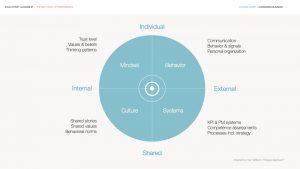Faster, higher, stronger? Break a leg…
We have stretched our current operating model to its limits. No amount of classic benchmarking, performance management, lean, change management, new IT systems, re-organization, etc. is likely to make any significant shift in performance anymore.
What you need is a new performance equation and clarity over the components of this equation.
In order to understand the modern, more complex but effective performance equation, let us look to the “Integral Approach” – the groundbreaking work of Ken Wilber. His 4Q model is based on two dimensions: individual versus collective, and inner versus outer – and it gives us four lenses through which we more fully understand any leadership situation or challenge.
Now, analyze performance through these 4 lenses:

Behavior & outcomes
Performance is about desired outcomes, often measured by dozens of KPI’s. Outcomes are a product of behavior and manifest as a result of what you did and did not do.
This also means that when you manage by KPIs you miss the point – and you are too late.
As a high-performance leader, you want to lead behavior, not manage KPI’s. Leading behavior requires a different skillset than what we’ve learned in business school. It requires your presence – not just physically – so you actually see and hear the specific behaviors at work.
Are you present? Do you talk about and give feedback on behavior as a natural part of your dialogue with your team? Shift your attention away from KPI’s and you are much more likely to get the desired outcomes.
Mindset – heart & brain
Behavior produces outcomes – and behavior is a product of Mindset, of the heart & brain we bring to work. Mindset is a complex personal “black box” filled with values, beliefs, experience, thinking patterns, biases, etc. that help you make sense of the world and decide what to do; this personal sense-making is intimately linked to how you feel about things, your “neurochemical soup” that equals your current state (“Am I OK with this?”)
In the mindset, there is a reason for every behavior, and there is also a way to motivate the desired behavior.
So, in order to get to high performance, you need to understand mindset (when you do this for yourself, it is Personal Leadership).
In your team, you do this by prioritizing time for dialogue and making an effort to truly understand the other person. Listening. Asking open, explorative questions. Leaving your own agenda out of the equation for a moment or two.
Are you truly interested in understanding the other person? Do you see potential? Do you consider development important? Are you comfortable with performance behavior dialogue? These are key elements of the high-performance leader’s mindset.
Culture & DNA
Culture indeed eats strategy and many good initiatives for breakfast. Culture is the cradle for high performance, and you want to manage your culture instead of letting it manage you.
Culture is an aggregate of the individual mindsets that come to work every day, as well as a product of what happens between individuals. For instance, what are the unspoken norms that have been created by your team’s dynamics until now?
Make sure you are shaping your culture every day in everything you say and do. How do you talk about performance? What are the stories you tell each other about performance and outcomes? What do people in your organization say about the performance dialogues? Do they look forward to them, value them, consider them important? Do people find it natural, and positive, to give each other feedback on performance behavior? Culture shapes the potential of the high-performance leadership you bring to your organization.
Shared systems
Ideally, systems, structures, and processes are designed to support us in our efforts towards desired outcomes. However, they tend to get a life of their own and become untouchable; more often than not, our shared systems get in the way of our best performance. The current paradigm that most businesses are built on (industrial/scientific/capitalistic) loves to measure and “prove” everything and naturally has come up with KPI’s. Your shared systems are likely KPI oriented. Performance Management systems are part of this paradigm and the question is, do your systems and processes support performance? Do they support constructive dialogue? Do they help translate your overarching vision, desired outcomes, and strategies to specific behavior that people can relate to? Make sure you test your systems against these questions and change or discard systems and processes that stand in your way.
In order to achieve high-performance leadership, we must ensure that we bring balance and coherence between the relevant elements from each of the four areas in the model. When these elements sustain and support each other, and when you develop with a keen eye on all four lenses, you will be able to tap into the performance potential of yourself and the organization you are part of.
With high-performance leadership, you will be able to move beyond restrictions in the noble but old idea of “Faster, higher, stronger” and fulfill your leadership role at a new level.


